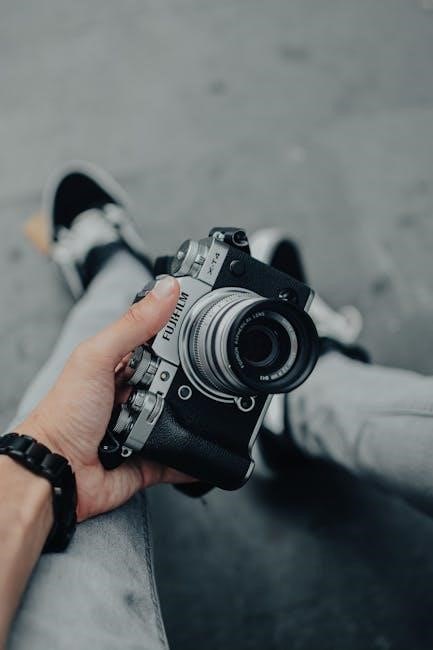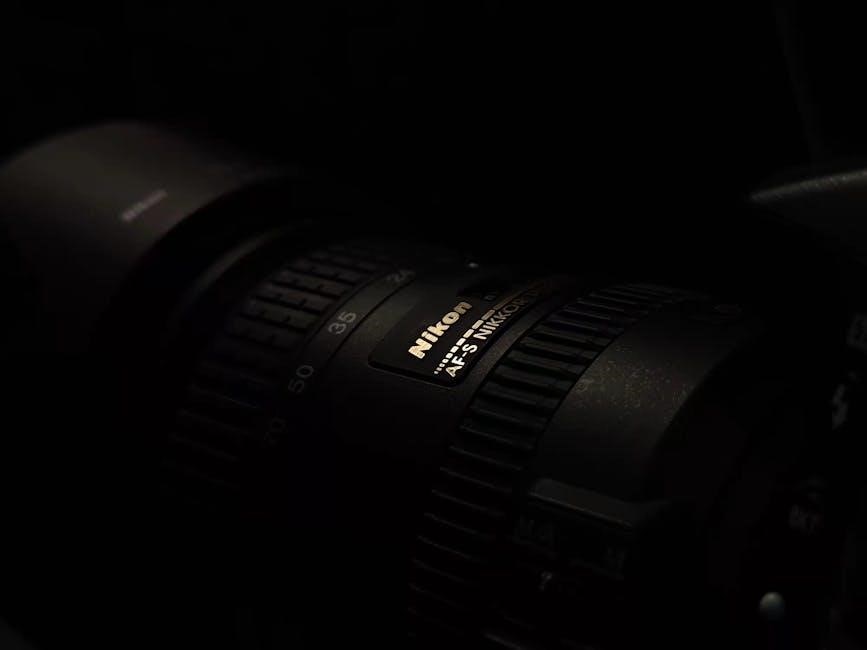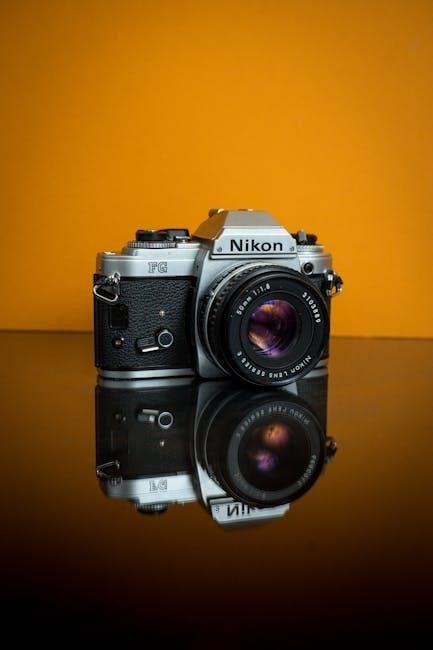The Nikon FM2 is a legendary 35mm film SLR camera‚ renowned for its durability‚ mechanical reliability‚ and advanced features‚ making it a favorite among photographers of all levels.
1.1 Overview of the Nikon FM2
The Nikon FM2 is a compact‚ mechanically robust 35mm SLR camera‚ offering exceptional durability and precision engineering. With a top shutter speed of 1/4000 sec and flash sync up to 1/250 sec‚ it is a versatile tool for professionals and enthusiasts‚ delivering outstanding performance in various photography conditions.
1;2 Importance of the Instruction Manual
The instruction manual is essential for understanding the Nikon FM2’s features and operations. It provides detailed guidance on setup‚ usage‚ and troubleshooting‚ ensuring users can fully utilize the camera’s capabilities. Regular reference to the manual helps photographers master the FM2’s advanced functions and maintain optimal performance in various shooting conditions.
Key Features and Specifications
The Nikon FM2 boasts a mechanically controlled shutter with a maximum speed of 1/4000 sec.‚ flash synchronization at 1/250 sec.‚ and a TTL full-aperture metering system for precise exposures.
2.1 Shutter Speed and Flash Synchronization
The Nikon FM2 features a mechanically controlled shutter with speeds from 1/4000 sec. to 1 sec.‚ plus Bulb mode. Flash synchronization is available at 1/250 sec.‚ enabling precise control for both ambient and flash photography in various lighting conditions‚ ensuring optimal exposures every time.
2.2 TTL Full-Aperture Metering System
The Nikon FM2 incorporates a TTL full-aperture metering system‚ providing accurate exposure measurements through the lens. This system ensures precise light evaluation‚ adapting to various lenses and shooting conditions‚ helping photographers achieve consistent and optimal results in diverse lighting environments with ease and reliability.
2.3 Compatibility with Lenses and Accessories
The Nikon FM2 offers extensive compatibility with a wide range of Nikon lenses and accessories‚ including optional focusing screens and external flash units. This versatility allows photographers to customize their setup according to specific needs‚ enhancing creativity and ensuring adaptability in various photographic situations with reliable performance and seamless integration.
Setting Up the Camera
Setting up the Nikon FM2 involves installing batteries‚ mounting the lens‚ and attaching the shoulder strap. This initial setup ensures the camera is ready for operation and provides a comfortable shooting experience‚ allowing photographers to focus on capturing their vision seamlessly and effectively.
3.1 Installing the Batteries
Installing batteries in the Nikon FM2 is straightforward. Remove the battery compartment cover‚ insert two LR44 or equivalent batteries‚ ensuring correct polarity‚ then replace the cover. Proper installation powers the meter‚ enabling accurate exposure measurements and ensuring reliable camera operation for photography sessions.
3.2 Mounting the Lens
Mounting a lens on the Nikon FM2 is simple. Remove the lens cap‚ align the lens mounting index with the camera’s mark‚ and turn the lens counterclockwise until it clicks into place. Ensure the lens is securely locked to guarantee proper alignment and prevent damage during use.
3.4 Attaching the Shoulder Strap
To attach the shoulder strap‚ locate the strap eyelets on both sides of the camera. Thread the strap through the eyelets‚ ensuring it is securely fastened. Adjust the strap length for comfort and balance‚ making sure it doesn’t interfere with camera operation or access to controls.

Basic Camera Operation
Mastering the Nikon FM2 begins with loading film‚ setting the ISO‚ and understanding shooting modes. These steps ensure proper functionality and prepare you for capturing exceptional images.
4.1 Loading the Film
Open the camera back by pulling the film advance lever. Insert the film cartridge‚ aligning it with the take-up spool. Gently pull the film leader across the spool‚ ensuring it fits securely. Advance the lever to start the film counter. Close the back and check the counter to confirm loading.
4.2 Setting the Film Speed (ISO)
Lift the ISO dial on the camera’s top plate and rotate it to match your film’s speed. Ensure the dial clicks into place for accurate exposure settings. Set this before loading film for optimal results‚ as the metering system relies on this input for precise calculations.
4.3 Understanding the Shooting Modes
The Nikon FM2 primarily operates in manual mode‚ offering full control over aperture and shutter speed. Use the aperture ring on the lens and the shutter speed dial on the camera to set exposures. The TTL metering system provides guidance‚ but adjustments are made manually for precise control over your shots.
Exposure Control
The Nikon FM2 offers precise exposure control through manual operation. Adjust aperture and shutter speed settings to achieve desired results‚ guided by the TTL full-aperture metering system for accurate exposures.
5.1 Aperture and Shutter Speed
The Nikon FM2 allows manual control of aperture and shutter speed‚ enabling precise exposure adjustments. With a maximum shutter speed of 1/4000 sec. and sync up to 1/250 sec.‚ it offers flexibility for various lighting conditions‚ ensuring optimal image capture in diverse photographic scenarios.
5.2 Using the Light Meter
The Nikon FM2 features a TTL full-aperture metering system‚ providing accurate light measurement. The built-in light meter ensures proper exposure by considering the lens aperture and film speed‚ offering reliable guidance for capturing well-balanced images in various lighting conditions effectively.
5.3 Adjusting Exposure Compensation
The Nikon FM2 allows for precise exposure compensation by adjusting the aperture or shutter speed. Use the exposure compensation dial to fine-tune settings‚ ensuring optimal results in challenging lighting conditions. This feature enhances creative control‚ enabling photographers to achieve perfectly balanced exposures effortlessly.

Focusing and Metering
The Nikon FM2 features interchangeable focusing screens and a TTL full-aperture metering system for precise focus and exposure control‚ ensuring sharp images and accurate light measurement.
6.1 Types of Focusing Screens
The Nikon FM2 offers optional focusing screens‚ including Type K2 (standard)‚ Type B2 (matte/Fresnel with spot)‚ and others‚ allowing photographers to choose the screen that best suits their shooting style and focus accuracy needs for optimal composition and clarity in various lighting conditions.
6.2 Using the Built-in Light Meter
The Nikon FM2 features a TTL full-aperture metering system‚ providing accurate exposure readings. Activate the meter by pressing the shutter release halfway. The center-weighted meter measures light through the lens‚ ensuring precise calculations based on the selected aperture and shutter speed‚ and works seamlessly with compatible lenses and flash units.
6.3 Manual Focusing Techniques
The Nikon FM2 excels in manual focusing‚ with a smooth‚ precise focusing ring. Use the viewfinder’s focusing screen for accurate focus. Optional interchangeable screens‚ like the Type B2 or K2‚ offer split-image or microprism aids‚ ensuring sharp focus. These tools enable precise control‚ helping photographers achieve crisp images every time.
Flash Photography
The Nikon FM2 supports flash photography with advanced features‚ including flash synchronization speeds up to 1/250 sec. It works seamlessly with external flash units‚ ensuring well-lit and balanced exposures in various lighting conditions.
7.1 Flash Synchronization Speeds
The Nikon FM2 offers flash synchronization speeds of up to 1/250 sec.‚ ensuring precise lighting control. This feature allows photographers to capture sharp images with balanced flash and ambient light‚ making it ideal for both indoor and outdoor settings with reliable results consistently.
7.2 Using External Flash Units
The Nikon FM2 supports external flash units via its dedicated hot shoe‚ ensuring compatibility with models like the SB-24. Connect the flash‚ set the synchronization speed to 1/250 sec.‚ and adjust settings as needed. This setup enhances lighting control‚ allowing for dynamic and balanced illumination in various photography scenarios‚ ensuring consistent results.
7.3 Balancing Flash and Ambient Light
Balancing flash and ambient light on the Nikon FM2 involves adjusting flash output and ambient exposure. Use the TTL metering system to measure light accurately. Experiment with ISO settings and aperture to blend natural and flash illumination seamlessly‚ creating harmonious and professional-looking results in various lighting conditions.

Advanced Shooting Techniques
The Nikon FM2 supports advanced techniques like multiple exposures and long exposures‚ offering precise control over creative aspects and ensuring reliability even without battery power.
8.1 Multiple Exposures
The Nikon FM2 allows photographers to create unique multiple exposure images by not advancing the film after each shot. This feature enables artistic layering of scenes‚ offering a creative way to capture complex compositions in a single frame without additional equipment or digital editing.
8.2 Long Exposure Photography
The Nikon FM2 excels in long exposure photography‚ allowing photographers to capture stunning images with creative blur and light trails. Using the bulb (B) mode‚ exposures can be extended indefinitely. For bright conditions‚ neutral density filters are recommended‚ and a tripod is essential to ensure sharp‚ steady results.
8.3 Bracketing Shots
Bracketing shots on the Nikon FM2 involves manually adjusting the aperture or shutter speed between exposures to capture a range of lighting conditions. Use the aperture ring or shutter speed dial to create variations‚ ensuring a tripod is used for consistent framing. This technique is ideal for high-contrast scenes.

Maintenance and Care
Regularly clean the camera and lens with a soft cloth to prevent dust buildup. Lubricate mechanical parts minimally. Store in a dry‚ cool place to maintain functionality and longevity.
9.1 Cleaning the Camera and Lens
Use a soft‚ dry cloth to gently wipe the camera body and lens surfaces. For stubborn smudges‚ dampen the cloth with distilled water‚ but avoid harsh chemicals. Regular cleaning ensures optimal performance and image clarity‚ preserving your Nikon FM2 for years of reliable use.
9.2 Lubrication and Mechanical Care
Regularly inspect and maintain the camera’s mechanical components to ensure smooth operation. Use Nikon-approved lubricants for moving parts‚ avoiding over-lubrication. Have a professional service the camera every 5-7 years to maintain precision and durability‚ ensuring optimal performance for years of reliable use.
9.3 Storing the Camera Properly
Store the Nikon FM2 in a cool‚ dry place away from direct sunlight and moisture. Use silica gel packets to prevent humidity damage. Keep the lens capped and avoid exposure to chemicals. Store the camera in its case to protect against dust and scratches‚ ensuring longevity and optimal functionality when not in use.
Troubleshooting Common Issues
The Nikon FM2 is reliable‚ but issues like shutter malfunctions or metering errors can occur. Always consult the manual or contact Nikon support for assistance and repairs.
10.1 Shutter Malfunction
A shutter malfunction can occur due to mechanical wear or improper use. Symptoms include slow or uneven curtain movement. Clean the shutter area gently and ensure batteries are fresh. If issues persist‚ consult the manual or contact a Nikon service center for professional repair.
10.2 Metering System Errors
Metering system errors can occur due to dirt‚ incorrect ISO settings‚ or faulty sensors. Clean the aperture and lens contacts. Ensure the ISO is set correctly and batteries are fresh. If issues persist‚ consult a professional for calibration or repair to maintain accurate exposure readings.
10.3 Film Loading Problems
Film loading issues can arise from improper alignment‚ tangled film‚ or forced loading. Ensure the film leader is correctly seated and aligned. Avoid forcing the film‚ as this may cause damage. If problems persist‚ rewind the film and reload it carefully‚ following the manual’s guidelines for smooth operation.

Accessories for the Nikon FM2
Explore a range of accessories‚ including optional focusing screens‚ remote shutter releases‚ and compatible flash units‚ to enhance your Nikon FM2 photography experience and creativity.
11.1 Optional Focusing Screens
The Nikon FM2 offers interchangeable focusing screens‚ such as the Type B2 (matte/Fresnel with a central focusing spot) and Type K2‚ enhancing composition and focusing precision for various photography styles and lighting conditions‚ ensuring optimal control over your creative vision in different shooting scenarios.
11.2 Remote Shutter Release
The remote shutter release enhances stability by minimizing camera shake during exposures‚ ideal for low-light conditions or long exposures. It connects via a cable‚ allowing photographers to trigger shots without physical contact‚ ensuring sharp images and reducing blur caused by manual shutter pressing.
11.3 Compatible Flash Units
The Nikon FM2 is compatible with various flash units‚ including the Nikon SB-24‚ offering TTL flash control for precise illumination. External flash units enhance versatility‚ providing additional lighting options for diverse photography scenarios while ensuring optimal performance and balanced results in both ambient and low-light conditions.
The Nikon FM2 is a legendary camera‚ offering reliability‚ precision‚ and versatility. Its advanced features and robust design make it a timeless choice for photographers. This manual ensures mastery of its capabilities‚ empowering users to achieve exceptional results in various photographic situations.
12.1 Summary of Key Features
The Nikon FM2 boasts a maximum shutter speed of 1/4000 sec‚ flash sync at 1/250 sec‚ and a TTL full-aperture metering system. It offers manual operation‚ compatibility with various lenses‚ and mechanical reliability without battery dependence‚ ensuring versatility for photographers in diverse shooting conditions. These features solidify its reputation as a robust and precise camera.
12.2 Final Tips for Optimal Use
Regularly clean and maintain the camera‚ familiarize yourself with manual controls‚ and experiment with different shooting modes. Store the FM2 properly when not in use to ensure longevity and optimal performance‚ allowing you to capture exceptional images consistently over time.

Additional Resources
Explore the official Nikon FM2 PDF manual‚ join photography forums for tips‚ and visit authorized service centers for professional maintenance and repairs.
13.1 Downloading the Full PDF Manual
The Nikon FM2 instruction manual is available for free download as a PDF file‚ offering detailed guidance on camera operation‚ features‚ and maintenance. Compatible with FM2‚ FM2n‚ and other variants‚ it provides a comprehensive guide for photographers of all skill levels to master their camera.
13.2 Online Forums and Communities
Online forums and photography communities are excellent resources for Nikon FM2 users‚ offering troubleshooting tips‚ usage advice‚ and discussions. Platforms like Nikon’s official forums‚ Reddit‚ and specialized photography groups provide valuable insights and support for mastering the camera and resolving common issues.
13.3 Repair and Service Centers
Nikon FM2 repair and service centers offer professional maintenance and repair services. Authorized centers provide genuine parts and expert troubleshooting‚ ensuring optimal performance. Users can access comprehensive support‚ including repair manuals and technical guidance‚ to keep their camera in peak condition and extend its lifespan.
